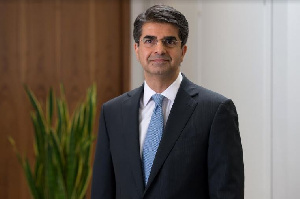 Tullow Oil Plc Chief Executive Officer, Rahul Dhir
Tullow Oil Plc Chief Executive Officer, Rahul Dhir
The country can significantly cushion itself against global energy shocks by developing its own gas resources, says Tullow Oil Plc Chief Executive Officer, Rahul Dhir.
Amid the ongoing geopolitics which has led to oil and gas prices reaching records not seen in decades, coupled with global energy transition trends, Mr. Dhir – whose Tullow is the country’s biggest producer – says the alarm bells are sounding toward the need to prioritise development of abundant local gas resources as an energy security strategy.
“The urgency is really around the facts that we see and read every day; for example, in Europe there is a concerted plan to move all the lines off oil and gas by 2028 – which means Liquefied Natural Gas (LNG) that would have come to Africa is no longer going to be available,” he said in Accra.
Currently, thermal power – power plants that depend on gas – account for approximately 80 percent of total power generation.
But as the price volatility occasioned by the ongoing Russia-Ukraine conflict continues, as well as global energy trends, the country’s energy security could be compromised if it fails to prioritise development of indigenous gas resources.
“As you look at government’s plan to increase power generation – thermal power, domestic gas which is our own gas that creates the most value, is a priority,” Mr. Dhir advocated
According to him,Tullow is capable of supplying about 135 million cubic feet of gas; approximately 30 percent of the country’s thermal demands, with potential to increase that to 225 million cubic feet from the same fields – Jubilee and TEN.
The CEO added that Tullow will have supplied 200 billion cubic feet of gas by end of 2022.
Meanwhile, the oil producer is eying a new gas commercialisation agreement with government, having recently put forward a proposal to develop another 500 billion cubic feet of gas, with Mr. Dhir saying: “There’s probably twice as much additional gas resources to be supplied”.
On a broader perspective, he said Ghana has a tremendous amount of gas resources in volume terms, and beyond what comes from Tullow.
For instance, Eni’s Sankofa and Gye Nyame Fields Offshore Cape Three Points (OCTP) come with significant gas resources.
Development activity of the OCTP oil and gas project was completed in 2019; and in 2020, 98 percent of Ghana’s thermal power was generated by gas… more than 50 percent of which came from the OCTP project.
Despite the abundance of gas resources, development of the resource – particularly supporting infrastructure, remains a challenge.
As a result, it is estimated that the country pays around US$700million yearly, as of last year, for unutilised gas – gas that the country is contracted to pay for but unable to utilise due to lack of infrastructure to move it to the end user.
A comprehensive indigenous gas development strategy, according to market watchers, could therefore set the country on a pathway to sustainable energy supply and security
- Decline in oil production threatens survival of oil companies in Ghana – PIAC warns
- Declining crude production threatens GNPC's Voltaian basin plans
- ‘Create stand-alone gender policy in petroleum value chain’ - Participants
- Ghana's extractive sector: 2023 in focus
- Angola quits OPEC amid dispute over oil production quotas
- Read all related articles
